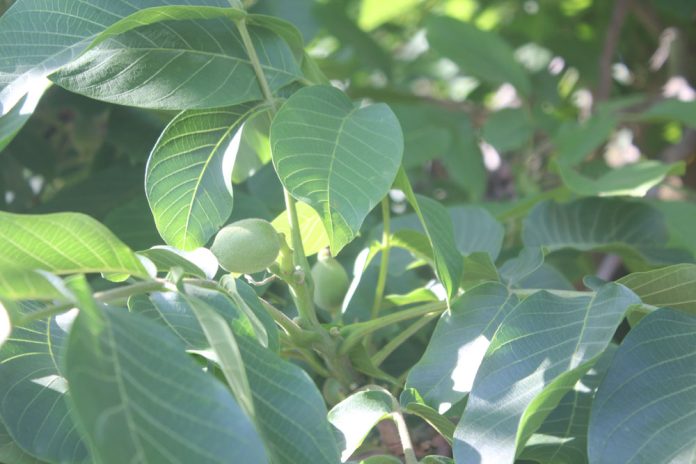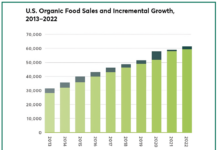
Leaf sampling in agricultural crops is a long-practiced sampling method where the analysis of the collected tissues is used to assess crop nutrient status. Sampling whole leaves, drying, grinding, digesting and then analyzing the sample for nutrient levels has aided farmers in managing their crop nutrition programs and optimizing crop yield.
This method, however, has some inherent limitations. Primarily, the results of the analysis are providing nutrient levels for ALL nutrients in the sample, including those that are structurally bound within cell walls, the leaf surfaces (cuticles) and organelles. While the analysis is accurate in quantifying the nutrient levels in the sample, these bound nutrients are largely immobile and unavailable to developing leaves and fruit.
Additionally, any nutrients found on the outside of the leaf or embedded in the leaf cuticle are included in the results. As an example, if a calcium carbonate material were applied foliarly to a crop and then tissue samples were pulled, the analysis would demonstrate that our tissue’s calcium levels increased. On the other hand, calcium carbonate materials have very poor foliar uptake and are commonly used as solar protectants or sunscreens. As a sunscreen, it is necessary that the material remains on the leaf surface to do its job, but a standard tissue sample analysis cannot differentiate between “in” or “on” the leaf. Further, tissues being prepped for analysis may be rinsed or washed in an attempt to alleviate leaf surface contaminants. What is commonly overlooked with this practice is the effect that rinsing can have on nutrients within the leaf. For instance, potassium, calcium, magnesium, manganese, nitrogen, phosphorus and zinc can all be leached to varying degrees from the leaf tissue with water.
Now, if the grower is analyzing the leaf tissue because it is the crop, then knowing the nutrient levels of the entire leaf structure and surface is appropriate. However, many growers are not selling leaves but are using the leaves as the machinery to develop the structure of the plant and produce the end crop. Whether that end crop is a tuber, fruit, nut, seed or simply a flower, knowing the number and quantity of nutrients available for assimilation within the plant as well as the balance among these nutrients may spell the difference between a mediocre crop and a stellar crop. Knowing and adjusting the nutrient balance is crucial to nutrient performance and preventing fruit nutrient disorders which can impact crop storability and shelf life. Other characteristics such as fruit sugar levels, size and color also can be positively impacted by proper nutrition.
Forward Looking Analysis
An alternative method to leaf tissue analysis is sap analysis. With sap analysis, leaves are sampled in sets with new leaves and old leaves collected separately without petioles. At the lab, a proprietary process under the NovaCrop brand then extracts the sap from the leaf. This process is done without rinsing, drying, grinding, cutting or crushing the leaves and the extracted sap is largely free from leaf structural components and surface contaminants. This results in the extracted sap being more similar to a blood sample than the biopsy approach akin to classical tissue sampling and analysis. In addition to analyzing the samples for 19 nutrients and five other nutrient and metabolic indicators, having the sap of both new and old leaves analyzed separately allows for the comparison of nutrient uptake, mobility and remobilization within the plant. This comparison is also valuable for assessing the movement of sugar in the plant, which is the plant’s initial building block and energy source.
Minerals, sugars and nitrogen-containing compounds, such as amino acids and proteins, found in the sap represent the majority of plant nutrients that are immediately available for use. By intentionally sampling and analyzing leaf sap, the results provide a forward-looking picture of the nutritional environment in which the plant is currently growing. With this information, deficiencies, toxicities and nutritional imbalances can be identified and corrected in a proactive manner, often before their physiological effects are visible. With traditional tissue analysis, the results are providing information largely about what has already happened nutritionally, leading to decisions being reactive in nature. As the demand for agricultural products continues to increase, farmers are often turning to more aggressive fertility programs, which frequently leads to over-applying nutrients or missing the best opportunity for the application.
Both over-applications and mistimed applications of nutrients can negatively affect crop yields and quality. The balance of nutrients within the plant can be upset by an over-applied nutrient. This can happen with foliar-applied nutrients as well as soil-applied nutrients. In some instances, as with nitrogen, it can alter the expression/regulation of genes and lead to a shift in growth toward vegetative and away from fruit development. In other cases, the over-applied nutrient can create nutrient imbalances that present as deficiency symptoms of other nutrients despite adequate concentration levels in the sap. This can be described as like-kind interactions where minerals of similar charge are competing with each other for space within the sap (cations affect cations and anions affect anions.) Physiological responses within the plant to an applied nutrient can modify the uptake or physiological activity associated with other nutrients, either positively or negatively.
Nutrient Availability
By removing unavailable nutrients from the analytical picture, the concentrations of available nutrients and their interactions are more easily seen in the analysis and accommodated for in the grower’s nutrition program. In the soil, colloidal and mineral properties influence how various nutrients, specifically cations, populate the cation exchange locations. A key takeaway is that these soil interactions occur primarily with available nutrients. The same is true within the plant with nutrient interactions primarily between available nutrients not unavailable and structurally bound nutrients. This is where sap analysis shines.
By quantifying the metabolically active and available nutrients in the sap and assessing their balance, growers are able to determine not just if nutrient deficiencies exist but also the future potential for nutrient deficiencies. With a NovaCrop sap analysis in hand, growers are able to evaluate the balance of nutrients in their crop and better understand how excessive levels of nutrients may impact the uptake and/or activity of others. Through this analytical report, a grower might determine that the most efficient way to increase the level of a certain nutrient is NOT by applying more of that nutrient, but rather is best achieved by decreasing the rate of other applied nutrients and restoring balance. Over-application of nutrients affect the safety of ground and surface water for human consumption and the wildlife dependent on those water sources. In an ever-increasingly regulated world, leaching and runoff of nutrients caused by over-application are not merely wasted money and crop potential, but could result in the grower being fined thousands of dollars, reclamation fees and civil judgements. Fertility management plan modifications, when based on NovaCrop sap analysis, and coupled with soil analysis, improves fertilizer use efficiencies and decreases over application of nutrients.













